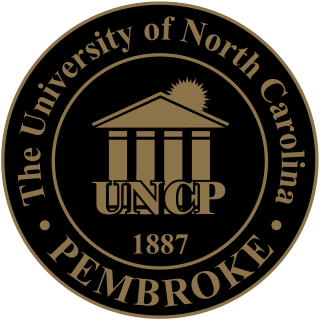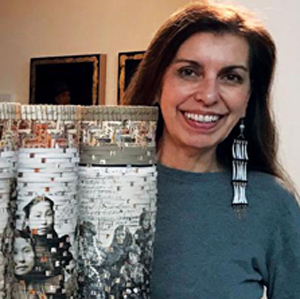
Robeson County is a county in the southern part of the U.S. state of North Carolina and is its largest county by land area. Its county seat and largest community is Lumberton. The county was formed in 1787 from part of Bladen County and named in honor of Thomas Robeson, a colonel who had led Patriot forces in the area during the Revolutionary War. As of the 2020 census, the county's population was 116,530. It is a majority-minority county; its residents are approximately 38 percent Native American, 22 percent white, 22 percent black, and 10 percent Hispanic. It is included in the Fayetteville-Lumberton-Pinehurst, NC Combined Statistical Area. The state-recognized Lumbee Tribe of North Carolina is headquartered in Pembroke.

The University of North Carolina at Pembroke is a public university in Pembroke, North Carolina. UNC Pembroke is a master's level degree-granting university and part of the University of North Carolina system. Its history is intertwined with that of the Lumbee nation.

The National Museum of the American Indian is a museum in the United States devoted to the culture of the Indigenous peoples of the Americas. It is part of the Smithsonian Institution group of museums and research centers.
The Lumbee are a mixed-race community primarily located in Robeson County, North Carolina, which claims to be descended from a myriad of indigenous tribes who once inhabited the region.

The Croatan were a small Native American ethnic group living in the coastal areas of what is now North Carolina. They might have been a branch of the larger Roanoke people or allied with them.
Helen Maynor Scheirbeck was an American educator and activist. Born in Lumberton, North Carolina, she was Assistant Director for Public Programs at the Smithsonian Institution National Museum of the American Indian. Scheirbeck was best known for her work with young Native Americans, training them to work with the United States Congress and other federal agencies in the United States to promote policies that help Indian communities.

Bacone College, formerly Bacone Indian University, is a private college in Muskogee, Oklahoma. Founded in 1880 as the Indian University by missionary Almon C. Bacone, it was originally affiliated with the mission arm of what is now American Baptist Churches USA. Renamed as Bacone College in the early 20th century, it is the oldest continuously operated institution of higher education in Oklahoma. The liberal arts college has had strong historic ties to several tribal nations, including the Muscogee and Cherokee. The Bacone College Historic District has been on the National Register of Historic Places listings in Muskogee County, Oklahoma since 2014.

Christi Marlene Belcourt is a Canadian visual artist and author. She is best known for her acrylic paintings which depict floral patterns inspired by Métis and First Nations historical beadwork art. Belcourt's work often focuses on questions around identity, culture, place and divisions within communities.
Nora Naranjo Morse is a Native American artist and poet. She currently resides in Española, New Mexico just north of Santa Fe and is a member of the Santa Clara Pueblo, part of the Tewa people. Her work can be found in several museum collections including the Heard Museum in Phoenix, Arizona, the Minneapolis Institute of Art in Minnesota, and the National Museum of the American Indian in Washington, DC, where her hand-built sculpture piece, Always Becoming, was selected from more than 55 entries submitted by Native artists as the winner of an outdoor sculpture competition held in 2005. In 2014, she was honored with a NACF Artist Fellowship for Visual Arts and was selected to prepare temporal public art for the 5x5 Project by curator Lance Fung.
Daniel C. Swan is an American cultural anthropologist and museum curator whose work has focused on documenting and interpreting the cultural history of the Americas. He has specialized particularly on the histories, social organizations, and cultures of Native North American peoples in Oklahoma, USA. His research on the history, significance, and artistic forms of the Native American Church has led to research and exhibition collaborations with artists and elders in a diversity of American Indian communities, both in Oklahoma and elsewhere in the Western United States. In addition to his work on American Indian topics, he has organized exhibitions and museum catalogs about cultural diversity in the American West and in the Western Hemisphere more broadly.

There have been a variety of ethnic groups in Baltimore, Maryland and its surrounding area for 12,000 years. Prior to European colonization, various Native American nations have lived in the Baltimore area for nearly 3 millennia, with the earliest known Native inhabitants dating to the 10th millennium BCE. Following Baltimore's foundation as a subdivision of the Province of Maryland by British colonial authorities in 1661, the city became home to numerous European settlers and immigrants and their African slaves. Since the first English settlers arrived, substantial immigration from all over Europe, the presence of a deeply rooted community of free black people that was the largest in the pre-Civil War United States, out-migration of African-Americans from the Deep South, out-migration of White Southerners from Appalachia, out-migration of Native Americans from the Southeast such as the Lumbee and the Cherokee, and new waves of more recent immigrants from Latin America, the Caribbean, Asia and Africa have added layers of complexity to the workforce and culture of Baltimore, as well as the religious and ethnic fabric of the city. Baltimore's culture has been described as "the blending of Southern culture and [African-American] migration, Northern industry, and the influx of European immigrants—first mixing at the port and its neighborhoods...Baltimore’s character, it’s uniqueness, the dialect, all of it, is a kind of amalgamation of these very different things coming together—with a little Appalachia thrown in...It’s all threaded through these neighborhoods", according to the American studies academic Mary Rizzo.
The history of Native Americans in Baltimore and what is now Baltimore dates back at least 12,000 years. As of 2014, Baltimore is home to a small Native American population, centered in East Baltimore. The majority of Native Americans now living in Baltimore belong to the Lumbee, Piscataway, and Cherokee peoples. The Piscataway people live in Southern Maryland and are recognized by the state of Maryland. The Lumbee and Cherokee are Indigenous to North Carolina and neighboring states of the Southeastern United States. Many of the Lumbee and Cherokee migrated to Baltimore during the mid-20th century along with other migrants from the Southern United States, such as African-Americans and white Appalachians. The Lumbee are state recognized in North Carolina as the Lumbee Tribe of North Carolina, but have no state recognition in Maryland. The Eastern Band of Cherokee Indians in North Carolina are a federally recognized tribe. There are three state recognized tribes in Maryland; the Piscataway-Conoy Tribe of Maryland, the Piscataway Indian Nation and Tayac Territory, and the Accohannock Indian Tribe. Maryland has no federally recognized tribes.

Shan Goshorn was an Eastern Band Cherokee artist, who lived in Tulsa, Oklahoma. Her interdisciplinary artwork expresses human rights issues, especially those that affect Native American people today. Goshorn used different media to convey her message, including woven paper baskets, silversmithing, painting, and photography. She is best known for her baskets with Cherokee designs woven with archival paper reproductions of documents, maps, treaties, photographs and other materials that convey both the challenges and triumphs that Native Americans have experienced in the past and are still experiencing today.
The Lumbee Regional Development Association (LRDA) is a nonprofit corporation, chartered by the State of North Carolina in 1968, organized to analyze and develop solutions for the health, educational, economic, and general welfare problems of rural and urban Indians in and around Robeson County. Its effective domain includes, but is not limited to, the Counties of Robeson, Hoke, Scotland, and Bladen, i.e., North Carolina’s Planning Region N. Federally funded programs are currently administered by the Lumbee citizens of these neighboring counties, from the LRDA offices in Pembroke, North Carolina. LRDA currently serves over 20,600 people each year. In July 2009, it had 62 full-time employees.
Blake Debassige was a Native Canadian artist of the M'Chigeeng First Nation, born at West Bay on Manitoulin Island in Ontario on June 22, 1956, passed June 13, 2022. A leading member of the "second generation" of Ojibwa artists influenced by Norval Morrisseau, Debassige has broadened the stylistic and thematic range of this group. Debassige's paintings and graphics frequently investigate traditional Anishabek teachings about the nature of cosmic order, the cycles of the seasons, the interdependence of animal, plant and human life and the common principles at work in the world's great spiritual systems. He frequently relates these themes to highly contemporary problems such as the destruction of the environment, the alienation of native youth and family dysfunction.
Sarah Biscarra-Dilley is a Native American interdisciplinary artist, curator, and writer from the Northern Chumash Tribe. Much of Biscarra-Dilley's work brings focus to sexuality and gender identity, as well as racial and cultural marginalization. These themes can be found throughout all of her work, whether it be in isolation or concurrently. Her works focus on the resiliency, self-determination, and sovereignty of Indigenous populations through the collaboration and shared experiences between communities, specifically within nitspu tiłhin ktitʸu, the State of California.
Brigid Globensky is the Senior Director of Education and Programs at the Milwaukee Art Museum, the largest art museum in Wisconsin. She previously acted as the Director of Education and Community Programs at the Baltimore Museum of Art. She is a museum educator.

Maggie Thompson is a Native American textile artist and designer from the Fond du Lac Ojibwe with a focus on "knitwear and tapestry". Her work focuses on her heritage and identity and also addresses cultural appropriation and Native authenticity. She is the director of the Two Rivers Gallery in Minneapolis,

The Indigenous peoples of Maryland are the tribes who historically and currently live in the land that is now the State of Maryland in the United States of America. These tribes belong to the Northeastern Woodlands, a cultural region.
Freda Porter, a member of the Lumbee Tribe of North Carolina, is an applied mathematician and environmental scientist known as one of the first Native American women to earn a PhD in the mathematical sciences. She is the president and CEO of Porter Scientific, Inc. and president of Lumbee Tribe Enterprises, LLC.











